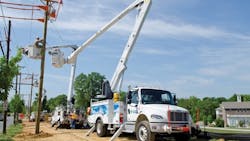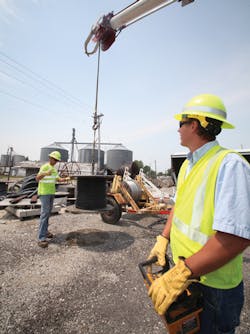Take a Look Inside a Lineman’s Bucket Truck
If you ask linemen what they can’t live without in the field, you’ll find that it doesn’t fit in a toolbox or on a shelf. It’s a bucket truck, and for today’s workforce, it’s a critical part of the utility fleet.
For example, Duke Energy now has about 500 trucks and has been using them for as long as he can remember, says John Evans, a learning services manager for Duke Energy.
“When I started in 1979, we didn’t have as many of them as we have now,” says the journeyman lineman. “When I came on board, we were climbing poles and doing mostly pole work. We had a bucket on the line truck, but it was sitting on the cab and was quite cumbersome to install.”
Times have changed, and over the years, manufacturers have made major modifications to these vehicles to make them more user-friendly, ergonomic, and safe and easy to operate. In turn, linemen are empowered to be more productive in the field.
Meeting Weight Restrictions
With all of the new technology available on the market, not to mention the necessary materials to get work done, it’s a challenge for linemen to decide what items to place on their trucks. As such, utilities often need to contend with weight restrictions set by the Department of Transportation.
Evans says crews can only put 20,000 lb on the real axle, and trucks typically weigh about 15,000 lb. Some tandem vehicles allow linemen to add more weight, but this requires a much larger truck with a wider turning radius, which isn’t always conducive to getting out of small neighborhoods.
On a typical day, a Duke Energy crew often loads up a truck with line hoses, rubber blankets to cover up bales, insulators and jumpers, and fiber-strapped hoists to move energized conductors. Within their tool bins, they’ll also need to carry steel grips for different wire sizes, two sets of personal climbing tools, rain gear, battery-operated hand tools, an inverter to charge batteries and connectors, bolts and other hardware.
Because the weight of all of these tools and equipment can add up quickly, Duke Energy tried to find ways to solve the problem of too much weight on the truck. For example, the company often requires linemen to pull a material trailer and purchases trucks with fiberglass (rather than steel or aluminum) bodies, which help to reduce weight.
“When we design a bucket or line truck, we design it with a lineman in mind,” Evans says. “We want them to easily get to equipment and to not have to worry about weight issues.”
At Kansas City Power & Light (KCP&L), the utility’s standards committee has made the trucks more heavy duty, so that they can withstand the weight and be legal to handle the necessary items like crossarms, insulators and palmer bells. With that in mind, however, it’s still a challenge for linemen to keep within the standard weight, especially when they need to carry an extra load of rock or other heavy materials.
Storage Solutions
To store all their necessary materials, linemen need bins and compartments on bucket trucks. Over time, these storage options have undergone significant improvements, says Tim Jones, supervisor of construction and maintenance for KCP&L. When he first began working for a contractor doing line work, he worked in a one-person bucket with no bins. As a result, he had to store everything in plastic boxes.
Now the bucket trucks offer adequate space for an everyday or emergency job, says Brian Doran, electric supervisor for Ameren Illinois. With countless compartments for any kind of tool or personal item, linemen can meet weight restrictions without leaving any necessary materials behind.
Ameren Illinois journeyman lineman Ryan Meuth with the joystick used to control the boom of the bucket truck.
Oftentimes, however, it takes careful planning and organization to accomplish this feat. Each morning at Xcel Energy, the linemen lay out the tool bins so they can carry the essentials but not carry a lot of excess materials on the trucks, says Scott Hindman, supervisor 2 for Xcel Energy.
They also keep organized with specialized tool storage bins with built-in partitions. For example, linemen store their tools in fiberglass tool boards with individual pockets or hydraulic gun holsters from Hi Line Utility Supply Co. The crews also store hot sticks in waterproof canisters that can be used in the trucks or in the buckets.
At Duke Energy, the bucket trucks now feature plywoodlined compartments to keep the tools dry, and corrugated material to keep the hot sticks in place and prevent them from rolling around inside the compartments.
The utility also has standardized the storage of items in the bins for each one of the bucket trucks. For example, the linemen store personal tools in one quadrant, chain hoists in a second, grips in the third and rubber goods in the final quadrant. This level of organization ensures that the linemen have the tools they need when they need them, even if they need to move to a different truck. “We are asking everyone to keep their truck organized in the same way so that they can go from one truck to another truck easily,” Evans says.
Improving the Design
Over the years, the trucks have become more ergonomically designed, Hindman says. For example, instead of a fixed bucket, it now rotates, which lessens the need for linemen to lean out and stretch to what they need to work on.
Hindman expects to see more remote control units in the future on digger derrick trucks. The operators hang a control box around their necks, and then instead of standing on the truck, they can walk around the site while operating the auger. By using trucks equipped with remote controls, the operator can get away from the truck and provide a better view, Doran says. Ameren Illinois is also using trucks with material handlers and booms designed to go over the center.
Journeyman lineman Ryan Meuth (foreground) uses a remote control with the help of apprentice lineman Craig Franklin to load a reel of wire with the winch line on a digger derrick line truck. Meuth and Franklin work out of Ameren Illinois’ Jerseyville, Illinois, operating center.
With the material handlers, the bucket trucks also have increased functionality, which improves productivity. For example, Dustin Taylor, a journeyman lineman for Rappahanoch Electric Cooperative, says he drives a High Ranger aerial bucket with a jib, which can lift up to 2,000 lb, making it easier for him to get the job done.
At Duke Energy, the fleet standards committee also requires material handlers and a sport boom on all of the twoperson buckets. In addition, this committee specifies that the 550 chassis and medium-duty chassis feature the telescopic boom, which makes it easier for the troublemen to change out a transformer without calling a line crew out, Evans says.
The utility uses trucks from Altec, which came up with a green dielectric pistol grip handle called an Isogrip. By using fiberglass rods instead of steel rods, if they make contact with another piece of boom, it doesn’t pass through to the pistol grip. In addition, the trucks have undergone various changes in attachment points for lanyards and how they are incorporated, Evans says.
Over time, the bucket trucks have gotten much more safe to operate, Jones says. In the past, linemen could use overrides to cheat with outriggers, but that is no longer the case. Now the crews need to set up the bucket trucks properly, and they can’t bypass any safety features.
“The trucks are a lot better and a lot more insulated,” says Jones, whose crews use a two-person walk-through bucket and a truck equipped with two single buckets. “Also, the buckets have to be set up just right or they won’t operate. Before that bucket raises out of the cradle, everything has to be correct. Our number-one priority is safety.”
Training the Linemen
With bucket trucks improving all the time, electric utilities need to educate their field workforce on the latest features and functionalities of the vehicles. When Duke Energy gets a new truck, it offers an in-service to go over all the safety features, do’s and don’ts, the type of fuel and the emissions systems, Evans says.
Duke also teaches its linemen how to safely get a person out of a bucket if he or she is incapacitated. The newer buckets have a rotate and dump function, which allows a coworker to help get a worker away from a pole. They can use a set of blocks attached to the strap on the boom and then pull them out with blocks and place them on the ground.
Through safety training, linemen are learning how to use their bucket trucks to perform their jobs safely and effectively. Instead of just relying on their climbing hooks, a passion for scaling poles and towers, and years of experience, they can work out of bucket trucks, allowing them to stay out in the field longer and minimize their loss time due to work-time injuries.
Editor’s note: In conducting research on bucket truck technology, the Electric Power Research Institute discovered that adding a step inside the bucket prevents postural instability when linemen enter or exit the bucket. For more information, visit www.epri.com.
Companies mentioned:
Altec | www.altec.com
Ameren Illinois | www.ameren.com
Duke Energy | www.dukeenergy.com
Hi-Line Utility Supply Co. | www.hilineco.com
Kansas City Power & Light | www.kcpl.com
Rappahannoch Electric Cooperative | www.myrec.coop
Xcel Energy | www.xcelenergy.com
Save
About the Author
Amy Fischbach
Electric Utilities Operations
Amy Fischbach is the Field Editor for T&D World magazine and manages the Electric Utility Operations section. She is the host of the Line Life Podcast, which celebrates the grit, courage and inspirational teamwork of the line trade. She also works on the annual Lineworker Supplement and the Vegetation Management Supplement as well as the Lineman Life and Lineman's Rodeo News enewsletters. Amy also covers events such as the Trees & Utilities conference and the International Lineman's Rodeo. She is the past president of the ASBPE Educational Foundation and ASBPE and earned her bachelor's and master's degrees in journalism from Kansas State University. She can be reached at [email protected].


